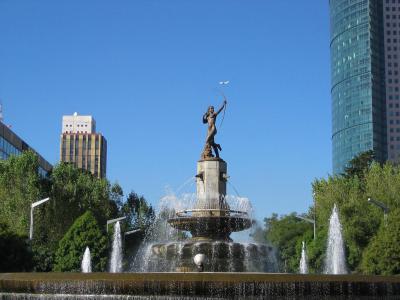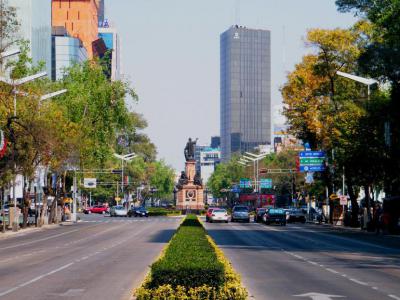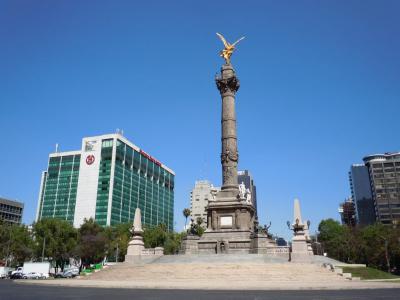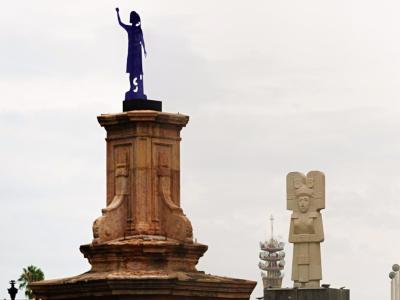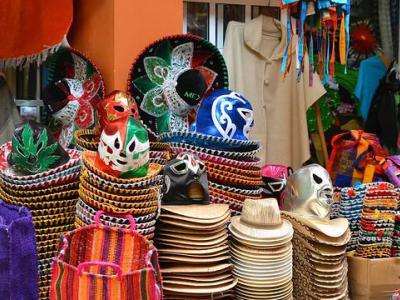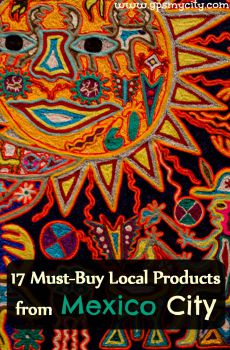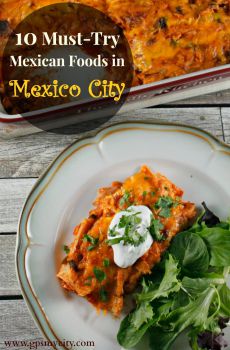
Zona Rosa Walking Tour (Self Guided), Mexico City
Zona Rosa, or "Pink Zone" in English, is a vibrant neighborhood near the historic center of the Mexican capital which is known for its lively atmosphere and diverse cultural scene. The neighborhood's name comes from the pink-colored tiles abundantly used to pave the local streets.
The area rose to prominence in the early 20th century as a residential district for the wealthy whose grand Beaux-Art mansions today have been repurposed as restaurants, shops, and cultural venues, blending the old with the new.
Just a stone's throw away from Zona Rosa is the renowned Paseo de la Reforma (Reformation Boulevard). Taking a stroll down this grand avenue, you can marvel at the majestic Angel of Independence, a towering monument symbolizing Mexico's struggle for independence. And venturing further along, you will come across the Monument to Christopher Columbus, honoring the renowned explorer.
While in Zona Rosa, don't miss the opportunity to check out the Fountain of Diana, a popular meeting point and one of the neighborhood's top landmarks, depicting the Roman goddess. For those seeking unique shopping experiences with a dose of Mexican craftsmanship, Zona Rosa offers two notable markets: La Ciudadela Market, a bustling marketplace that specializes in traditional Mexican handicrafts and artwork; and the San Juan Crafts and Curiosities Market.
The expression “Getting lost in Zona Rosa” ("Perderse en la Zona Rosa") is used to describe the vibrant and captivating nature of the area, suggesting that its liveliness and busy vibe that can easily get one lost in its charm. Indeed, to anyone armed with the GPSmyCity self-guided mobile app, and thus devoid of fear of getting lost literally, this may be a good option.
The area rose to prominence in the early 20th century as a residential district for the wealthy whose grand Beaux-Art mansions today have been repurposed as restaurants, shops, and cultural venues, blending the old with the new.
Just a stone's throw away from Zona Rosa is the renowned Paseo de la Reforma (Reformation Boulevard). Taking a stroll down this grand avenue, you can marvel at the majestic Angel of Independence, a towering monument symbolizing Mexico's struggle for independence. And venturing further along, you will come across the Monument to Christopher Columbus, honoring the renowned explorer.
While in Zona Rosa, don't miss the opportunity to check out the Fountain of Diana, a popular meeting point and one of the neighborhood's top landmarks, depicting the Roman goddess. For those seeking unique shopping experiences with a dose of Mexican craftsmanship, Zona Rosa offers two notable markets: La Ciudadela Market, a bustling marketplace that specializes in traditional Mexican handicrafts and artwork; and the San Juan Crafts and Curiosities Market.
The expression “Getting lost in Zona Rosa” ("Perderse en la Zona Rosa") is used to describe the vibrant and captivating nature of the area, suggesting that its liveliness and busy vibe that can easily get one lost in its charm. Indeed, to anyone armed with the GPSmyCity self-guided mobile app, and thus devoid of fear of getting lost literally, this may be a good option.
How it works: Download the app "GPSmyCity: Walks in 1K+ Cities" from Apple App Store or Google Play Store to your mobile phone or tablet. The app turns your mobile device into a personal tour guide and its built-in GPS navigation functions guide you from one tour stop to next. The app works offline, so no data plan is needed when traveling abroad.
Zona Rosa Walking Tour Map
Guide Name: Zona Rosa Walking Tour
Guide Location: Mexico » Mexico City (See other walking tours in Mexico City)
Guide Type: Self-guided Walking Tour (Sightseeing)
# of Attractions: 6
Tour Duration: 2 Hour(s)
Travel Distance: 3.7 Km or 2.3 Miles
Author: doris
Sight(s) Featured in This Guide:
Guide Location: Mexico » Mexico City (See other walking tours in Mexico City)
Guide Type: Self-guided Walking Tour (Sightseeing)
# of Attractions: 6
Tour Duration: 2 Hour(s)
Travel Distance: 3.7 Km or 2.3 Miles
Author: doris
Sight(s) Featured in This Guide:
- Fountain of Diana
- Paseo de la Reforma
- Angel of Independence
- Monument to Christopher Columbus
- La Ciudadela Market
- San Juan Craft Market / Mexican Curiosities
1) Fountain of Diana
The fountain of Diana stands on a roundabout near the Paseo de Reforma in Mexico City. The statue of Diana the Huntress is depicted by the sculptor as aiming her bow and shooting the arrow to the skies.
In 1942, architect Vincente Mendiola and Sculptor Juan Olaguibel were commissioned to build a fountain in a roundabout near the entrance of Chapultepec Park on the Reforma Avenue. The commission was the result of a beautification drive of Mexico City by the then President, Manuel Avila Camacho. A 16 year old secretary, Helvia Martinez was chosen as a model for the fountain. She posed for the sculptor for free knowing that her body would be immortalized in a landmark of Mexico City. On October 10th 1942, the statue was inaugurated. Some sections of the population appreciated the sculpture while ultra conservative sections of society called the Decency League protested against the nude depiction of Diana and forced the artist to put underwear on the statue. Before the 1968 Olympics, it was decided to remove the underwear but the attempt damaged the statue. The statue was removed to Ixmiquilpan, the home town of Juan Olaguibel. By popular demand by artists and citizens, the statue was restored in 1992.
The roundabout at the entrance to Chapultepec Park is decorated by a beautiful fountain and a sculpture that remains a fitting tribute to artistic freedom that survives despite setbacks.
In 1942, architect Vincente Mendiola and Sculptor Juan Olaguibel were commissioned to build a fountain in a roundabout near the entrance of Chapultepec Park on the Reforma Avenue. The commission was the result of a beautification drive of Mexico City by the then President, Manuel Avila Camacho. A 16 year old secretary, Helvia Martinez was chosen as a model for the fountain. She posed for the sculptor for free knowing that her body would be immortalized in a landmark of Mexico City. On October 10th 1942, the statue was inaugurated. Some sections of the population appreciated the sculpture while ultra conservative sections of society called the Decency League protested against the nude depiction of Diana and forced the artist to put underwear on the statue. Before the 1968 Olympics, it was decided to remove the underwear but the attempt damaged the statue. The statue was removed to Ixmiquilpan, the home town of Juan Olaguibel. By popular demand by artists and citizens, the statue was restored in 1992.
The roundabout at the entrance to Chapultepec Park is decorated by a beautiful fountain and a sculpture that remains a fitting tribute to artistic freedom that survives despite setbacks.
2) Paseo de la Reforma (must see)
Inspired by the grandeur of the Champs-Élysées in Paris, Paseo de la Reforma (Promenade of the Reform) serves as the principal thoroughfare in Mexico City, passing through the Historic district, as well as hosting Embassies and upscale residential buildings. Originally known as the Paseo de la Emperatriz or the road of the Empress, this splendid avenue was envisioned by Emperor Maximilian I of Mexico. Its purpose was to connect his residence at the Chapultepec Castle to the National Palace, which stands adjacent to the Zocalo. However, during President Benito Juarez's reformist era, the avenue underwent a transformation, becoming the Paseo de la Reforma we know today. The avenue's layout, crafted in 1860 by Ferdinand Von Rosenzweig, stands as a testament to its timeless elegance.
Stretching 15 kilometers in length and boasting a width of 60 meters, Paseo de la Reforma encompasses 6 to 8 traffic lanes, along with a prominent green strip running through its center, distinguished by a unique design. At the intersections, one can find grand roundabouts adorned with striking monuments. These monuments feature busts of revered figures who have played instrumental roles in shaping the history of Mexico.
In the present day, Paseo de la Reforma has evolved into a bustling hub, home to prominent office buildings, museums, impressive monuments, luxurious hotels, and vibrant cinemas. Moreover, it proudly hosts the embassies of notable nations such as the United States, the European Union, and the Mexican Stock Exchange.
With its rich historical legacy and modern-day significance, Paseo de la Reforma stands as a testament to the harmonious blend of Mexico's past and present, attracting visitors and locals alike to partake in its grandeur and cultural significance.
Tip:
On Sundays, the avenue closes down to cars so that multitudes of people can ride bikes, walk, jog, rollerblade or stroll down the street from the park all the way up to the historic center.
You can pay for bike rental or get one for free (first come, first served) if you bring your ID/passport and arrive early.
Stretching 15 kilometers in length and boasting a width of 60 meters, Paseo de la Reforma encompasses 6 to 8 traffic lanes, along with a prominent green strip running through its center, distinguished by a unique design. At the intersections, one can find grand roundabouts adorned with striking monuments. These monuments feature busts of revered figures who have played instrumental roles in shaping the history of Mexico.
In the present day, Paseo de la Reforma has evolved into a bustling hub, home to prominent office buildings, museums, impressive monuments, luxurious hotels, and vibrant cinemas. Moreover, it proudly hosts the embassies of notable nations such as the United States, the European Union, and the Mexican Stock Exchange.
With its rich historical legacy and modern-day significance, Paseo de la Reforma stands as a testament to the harmonious blend of Mexico's past and present, attracting visitors and locals alike to partake in its grandeur and cultural significance.
Tip:
On Sundays, the avenue closes down to cars so that multitudes of people can ride bikes, walk, jog, rollerblade or stroll down the street from the park all the way up to the historic center.
You can pay for bike rental or get one for free (first come, first served) if you bring your ID/passport and arrive early.
3) Angel of Independence
The Angel of Independence (Columna de la Independencia) stands as a symbol of both jubilation and dissent. Erected to commemorate the 100th anniversary of Mexican Independence and honor its heroes, this magnificent monument graces the Paseo Reforma roundabout in Mexico City.
In the year 1902, President Porfirio Diaz entrusted the task of creating this sculpture. The skilled Italian sculptor, Aciati, crafted the adorned figures while architect Antonio Rivas Mercado designed the overall structure. Originally, the Angel was intended to mark Mexico's centennial Independence celebration. However, in 1925, it was further designated as a mausoleum for esteemed heroes. Beneath its foundations rest the remains of revered figures like Miguel Hidalgo, Juan Aldama, and Nicolas Bravo.
Though tragedy struck in 1957 when an earthquake caused the Angel to fall from its pillar, sculptor Jose Fernandez Urbina adeptly restored it to its former glory. An eternal flame was added in 1929, a poignant symbol paying homage to the interred heroes.
Crafted with a blend of steel and quarried stone, the 36-meter tall column boasts intricate carvings of garlands, palms, and rings. These carvings also bear the names of significant personalities pivotal to Mexico's independence struggle. Atop the column, a majestic 6.7-meter bronze angel, coated with 24-carat gold, surveys the surroundings.
For those who venture inside the column, a concealed staircase leads to the Corinthian-style Capital. Furthermore, at night, the angel is artfully illuminated, providing a breathtaking sight for passersby. The Angel of Independence, standing tall and resolute, remains an everlasting testament to Mexico's rich history and the valor of its heroes.
Tip:
Tours to the Angel normally include only a walk around inside the statue's base and its mini-museum; however, with advance notice and a special permit, groups can ascend the statue's inner staircase and go all the way to the top for a glimpse at the city below – a breathtaking site!
In the year 1902, President Porfirio Diaz entrusted the task of creating this sculpture. The skilled Italian sculptor, Aciati, crafted the adorned figures while architect Antonio Rivas Mercado designed the overall structure. Originally, the Angel was intended to mark Mexico's centennial Independence celebration. However, in 1925, it was further designated as a mausoleum for esteemed heroes. Beneath its foundations rest the remains of revered figures like Miguel Hidalgo, Juan Aldama, and Nicolas Bravo.
Though tragedy struck in 1957 when an earthquake caused the Angel to fall from its pillar, sculptor Jose Fernandez Urbina adeptly restored it to its former glory. An eternal flame was added in 1929, a poignant symbol paying homage to the interred heroes.
Crafted with a blend of steel and quarried stone, the 36-meter tall column boasts intricate carvings of garlands, palms, and rings. These carvings also bear the names of significant personalities pivotal to Mexico's independence struggle. Atop the column, a majestic 6.7-meter bronze angel, coated with 24-carat gold, surveys the surroundings.
For those who venture inside the column, a concealed staircase leads to the Corinthian-style Capital. Furthermore, at night, the angel is artfully illuminated, providing a breathtaking sight for passersby. The Angel of Independence, standing tall and resolute, remains an everlasting testament to Mexico's rich history and the valor of its heroes.
Tip:
Tours to the Angel normally include only a walk around inside the statue's base and its mini-museum; however, with advance notice and a special permit, groups can ascend the statue's inner staircase and go all the way to the top for a glimpse at the city below – a breathtaking site!
4) Monument to Christopher Columbus
Located in one of the many rotundas intersecting the Paseo de la Reforma in Mexico City, is a statue dedicated to Christopher Columbus and the Christianization of the Americas.
The plan for installing a statue in honor of Christopher Columbus was conceived during the rule of Emperor Maximilian I. The emperor’s father in law King Leopold I of Belgium expressed his desire to donate a statue of Columbus commemorating the discovery of America. At the time, the Emperor commissioned the architect Ramon Rodriguez Aragoity to design the monument and sculptor Manuel Vilar was to fabricate the figures that would adorn the edifice. The statue was not erected because the Emperor was deposed and executed during the reign of the liberals in Mexico. Later, Antonio Escandon, a loyalist of the emperor and the pioneer of railways in Mexico commissioned a sculpture of Christopher Columbus while in exile in Paris. The sculptor to whom the work was entrusted was Frenchman Henri Joseph Cardier. Escandon later donated the sculpture to Mexico City and it was erected at the location originally planned by Emperor Maximilian.
The statue is placed on a pink pedestal with renaissance art and two stone carvings called the Landing of Christopher Columbus and the Founding of the Church. Four other sculptures are those of the first catholic missionaries who began the task of conversion of the native people of the Americas.
The plan for installing a statue in honor of Christopher Columbus was conceived during the rule of Emperor Maximilian I. The emperor’s father in law King Leopold I of Belgium expressed his desire to donate a statue of Columbus commemorating the discovery of America. At the time, the Emperor commissioned the architect Ramon Rodriguez Aragoity to design the monument and sculptor Manuel Vilar was to fabricate the figures that would adorn the edifice. The statue was not erected because the Emperor was deposed and executed during the reign of the liberals in Mexico. Later, Antonio Escandon, a loyalist of the emperor and the pioneer of railways in Mexico commissioned a sculpture of Christopher Columbus while in exile in Paris. The sculptor to whom the work was entrusted was Frenchman Henri Joseph Cardier. Escandon later donated the sculpture to Mexico City and it was erected at the location originally planned by Emperor Maximilian.
The statue is placed on a pink pedestal with renaissance art and two stone carvings called the Landing of Christopher Columbus and the Founding of the Church. Four other sculptures are those of the first catholic missionaries who began the task of conversion of the native people of the Americas.
5) La Ciudadela Market
La Ciudadela is a Mexico City experience: an exposure to its color, the variety of its crafts and the charm of its people. Go even if just to browse a bit; you will likely come away with a woven wallet, table runner or purse, small pottery boxes for friends or a serving piece for your table, toys for the children in your life, or one of the many other offerings. Prices are good, but it it best to start with "Cuánto cuesta?" (Spanish for "How much?") and it helps to know a few numbers so that you can bargain (which most vendors will) a price. If you can not master the numbers, take a small pad, point to it when you ask "Cuánto cuesta?" and then write your offer and haggle that way (but remember that many of the items are not that expensive to begin with). Fairness gets you a long way.
The market is made up of many different stalls, so if you have time, be sure to work your way to the center, comparing prices and quality, before you buy. Also, many of the vendors selling smaller items only take cash while others accept credit cards as well (though, in case of the latter, there will be far less negotiating on price).
The market is made up of many different stalls, so if you have time, be sure to work your way to the center, comparing prices and quality, before you buy. Also, many of the vendors selling smaller items only take cash while others accept credit cards as well (though, in case of the latter, there will be far less negotiating on price).
6) San Juan Craft Market / Mexican Curiosities
In the heart of Mexico City's historic center, the San Juan Market is a vibrant hub of commerce and culture. With a legacy of over 150 years, it consists of four public markets. The San Juan Crafts and Curiosities Market is an indoor market spread over two floors, showcasing a rich collection of traditional handicrafts from Mexico. Discover pottery, fabric, woodwork, jewelry with precious stones, and more. The air is filled with the scent of genuine leather goods like belts, wallets, and bags.
The array of artisanal goods doesn't end there. Stroll through the aisles and you'll find an assortment of culturally inspired t-shirts, intricately designed masks, charming tablecloths, and more. The market is a treasure trove of souvenirs and mementos that you can take home to remember your time in Mexico City.
With over 100 stores focusing on Mexican hand-made crafts, the Mercado de San Juan offers a plethora of choices to cater to every taste and preference. The vendors are known for their politeness and friendliness, making the shopping experience all the more enjoyable. Bargaining is a common practice here, so don't hesitate to strike up a conversation and try to get a great deal on your desired items.
The array of artisanal goods doesn't end there. Stroll through the aisles and you'll find an assortment of culturally inspired t-shirts, intricately designed masks, charming tablecloths, and more. The market is a treasure trove of souvenirs and mementos that you can take home to remember your time in Mexico City.
With over 100 stores focusing on Mexican hand-made crafts, the Mercado de San Juan offers a plethora of choices to cater to every taste and preference. The vendors are known for their politeness and friendliness, making the shopping experience all the more enjoyable. Bargaining is a common practice here, so don't hesitate to strike up a conversation and try to get a great deal on your desired items.
Walking Tours in Mexico City, Mexico
Create Your Own Walk in Mexico City
Creating your own self-guided walk in Mexico City is easy and fun. Choose the city attractions that you want to see and a walk route map will be created just for you. You can even set your hotel as the start point of the walk.
Historic Center Walking Tour
Mexico City is the oldest capital in the Americas and is one of the two founded by indigenous people. Originally known as Mexico Tenochtitlan, the city was built by the Mexicas (aka Aztecs) in 1325. According to a legend, the Mexicas' principal god, Huitzilopochtli, pointed out the site of the future settlement with an image of a golden eagle perched on a prickly pear cactus, devouring a... view more
Tour Duration: 2 Hour(s)
Travel Distance: 2.7 Km or 1.7 Miles
Tour Duration: 2 Hour(s)
Travel Distance: 2.7 Km or 1.7 Miles
Chapultepec Park Walking Tour
Nicknamed "the Lungs of Mexico City", Chapultepec Park is a vast oasis of lush greenery in the heart of the Mexican capital, sprawling over 686 hectares of land, providing a vital source of oxygen for the city. Rich in natural beauty, historical landmarks, and vibrant atmosphere, throughout centuries, this park has inspired various works of literature, poetry, and visual art, further... view more
Tour Duration: 2 Hour(s)
Travel Distance: 3.8 Km or 2.4 Miles
Tour Duration: 2 Hour(s)
Travel Distance: 3.8 Km or 2.4 Miles
Coyoacan District Walking Tour
Translated from the Nahuatle language as “The Land of Coyotes”, Coyoacán is a relatively quiet neighborhood in the southern part of Mexico City. Formerly a rural village, over the years Coyoacán has become a rich pocket of art and history in the capital, closely associated with some iconic figures of the 20th century and the tumultuous times in which they lived.
One of its most famous... view more
Tour Duration: 1 Hour(s)
Travel Distance: 2.6 Km or 1.6 Miles
One of its most famous... view more
Tour Duration: 1 Hour(s)
Travel Distance: 2.6 Km or 1.6 Miles
Historic Center Food Tour
A combination of history and tradition in Mexico City permeates all aspects of life, including food. For centuries, food and drink have been an inseparable part of the city's culture. Within Mexico City's bustling historic center, you can find a variety of culinary gems that offer a taste of what we call diverse Mexican cuisine.
One of the must-visit spots here is the San Juan Market.... view more
Tour Duration: 1 Hour(s)
Travel Distance: 1.6 Km or 1 Miles
One of the must-visit spots here is the San Juan Market.... view more
Tour Duration: 1 Hour(s)
Travel Distance: 1.6 Km or 1 Miles
Useful Travel Guides for Planning Your Trip
Souvenir Shopping Guide: 17 Must-Buy Local Products from Mexico City
Both historic and modern day Mexico's are worth each other in terms of cultural and artistic heritage. The country's capital Mexico City is a showroom of what the label "Made in Mexico" stands for in its entirety. Whether it's authentic food, drink or piece of craftsmanship...
10 Must-Try Mexican Foods in Mexico City
While Mexico is a treasure trove in terms of cultural and artistic heritage (ancient history, architecture, etc.), the vast majority of visitors to the country are lured mainly by, let's face it, bodily pleasures. The latter are manifested in the form of sandy beaches, sun and, most...
The Most Popular Cities
/ view all
